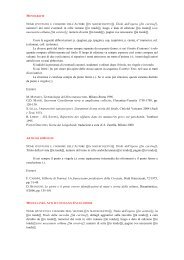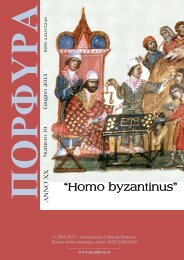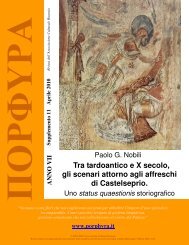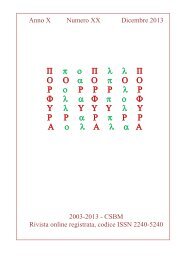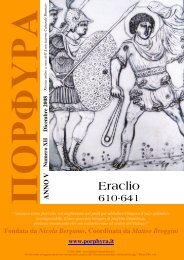ΠΟΡΦΥΡΑ - Porphyra
ΠΟΡΦΥΡΑ - Porphyra
ΠΟΡΦΥΡΑ - Porphyra
You also want an ePaper? Increase the reach of your titles
YUMPU automatically turns print PDFs into web optimized ePapers that Google loves.
A Prôtospatharios, Magistros, and Strategos Autokrator of 11 th cent.<br />
the equipment of Georgios Maniakes and his army according to the Skylitzes Matritensis miniatures<br />
and other artistic sources of the middle Byzantine period.<br />
introduction by the Avars in 6 th century 185 to the last days of the<br />
Empire they were called σκαλαι 186 . The specimen here used<br />
(Plate 1A and fig.9 n. 16) has been copied from Bulgaro-<br />
Byzantine examples found in Madara 187 , for its similarity with<br />
those of fig. 3. Skalai were protruding from the anterior part of<br />
the saddle, passed through a strap by means of their upper<br />
hole 188 .<br />
The use of spurs is well attested in literature as well as in<br />
military treatises 189 , and in the miniatures of the Skilitzés. 190<br />
Since the Caesarian age there is uninterrupted archaeological<br />
evidence for the use of spurs by Roman cavalrymen 191 , and<br />
East-Roman 10 th – 11 th century specimens have been found in<br />
Pacului Lui Soare 192 .<br />
Horseshoes were used by East-Roman cavalry (fig.9 n.<br />
17) specimens of which were found in Pacului Lui Soare 193 .<br />
Similar pieces come from Dinogetia and Cocon, and also other,<br />
fragmentary and sometimes still with nails attached, were found<br />
nearby in Seuthopolis and Pliska 194 .<br />
Hoffmeyer has tried a graphical reconstruction of<br />
different kinds of σελλοχαλινα from the Skilitzès 195 . Maniakes<br />
saddle, covered in the miniature by a green blocked cloth 196 , has<br />
been copied in these reconstructions (plate 1A and fig. 9). We<br />
185 S. Haldon, Military Technology, p. 22 note 57 ; Haldon, Warfare, p. 130 ; Nicolle, Medieval Warfare, 38.<br />
186 Maurikios, Strategikon, I, 2, 41 ; Leo, Taktika, V, 10 ; Du Cange, Glossarium, col. 1378.<br />
187 Feher, Les monuments, p. 76. They are probably relative to the Bulgarian war of Basil II and they find exactly<br />
correspondence in some type showed in manuscripts from 10 th centuries onwards. See for instance the 11 th cent. ivory<br />
ikon of Saint George in Kiew, in Heath, Byzantine Armies, p. 9 ; the Cod.Ath.Ephigmenu 14 fol. 417r, in Treasures, II,<br />
fig. 405 p. 251; the Skilitzès folio 113v, in Von Falkenhausen, I Bizantini. I have worked with a scanner on the image<br />
of the miniature. The type is flat, very arched.<br />
188 Cfr. the reconstruction of saddlery in Ambros, The stirrups, fig. 2 ; Laszlo, Etudes, fig. 85.<br />
189 Pternistéria: see Digenis Akritas, IV, 227 ; Leo, Taktika, VI,4 ; Pseudo-Konstantinos-Nikephoros Ouranos, Taktika,<br />
p.14.<br />
190 Es. Skilitzès Matritensis folios 43r, 178r, 224v, in Von Falkenhausen-Cavalli, cit., figg. 24, 36, 428.<br />
191 For classical roman spurs see Junkelmann, Die Reiters Rom, III, Mainz 1992, pp. 98-100 figg. 2, 4, 53.<br />
192 It is a singular straight iron arms specimen 14 cm. long, with rectangular section and wide arc. At a meeting point<br />
starts horizontally a bar 2,2 cm. long, which ends in the middle of a triangular pyramidal prominence 1 cm. long. One<br />
of the arms, integrally preserved, is lightly curved towards the top and extends vertically towards the ends, where two<br />
circular apertures to fasten the thongs were provided. Typologic on the basis of a more adequate and extended analog<br />
of the spur should be dated between the last 10 th cent. and the beginning of 11 th cent. See Diaconu-Vilceanu, cit., pp.<br />
144-145, fig. 107/4 and pl.22/3. Other specimen of the same period found in East-Roman context (Karatas) is published<br />
by Jancovic M., Implements and weapons from 9 th - 11 th centuries, in Balcanoslavica 10, 1983, pp. 55-69, p. pl. IV n. 9.<br />
193 Idem, p. 147, pl. 20 n. 3,6 p. 213. There were discovered two similar iron specimens, almost well preserved, whose<br />
form and dimension for the first time induce us to consider them as real horseshoes, which normally are wider with<br />
apertures to put them on. The specimens present a oval form which lightly widens towards the inside ends. Their<br />
thickness is 3 mm.; their length respectively 9,3 and 8,9 mm.; their width, 1,5 and 1,2 mm. at the linking point of arms<br />
which are thinner at ends. One of the two has come down to us with crumpled arms on the vertical line. Both preserve<br />
on the back two nails to fasten it at the hoof heel. We should at this point remember that the hooves of Maniakes<br />
horses, at the battle of Troina, were equipped with metal plates and shoes, s. Felix, Byzanz, p. 210 und bibliography in<br />
note 68 ;<br />
194 For Dinogetia cfr. Barnea, Dinogetia, fig. 40/20 ; for Seuthopolis s. Cangova J., La cité médiévale au dessus des<br />
ruines de la ville Thrace de Seuthopolis, Sofia 1972, p. 90 fig. 72; for Pliska cfr. Mihailov S., Pliska, 1945-1947, p. 181<br />
fig. 12/2.<br />
195 Hoffmeyer, Byzantine Equipment, cit. fig. 14.<br />
196 The reference cloth, with geometric and foliate motifs, is published in Malthusius, Byzantine silk., p. 217, pl.29a.<br />
32



